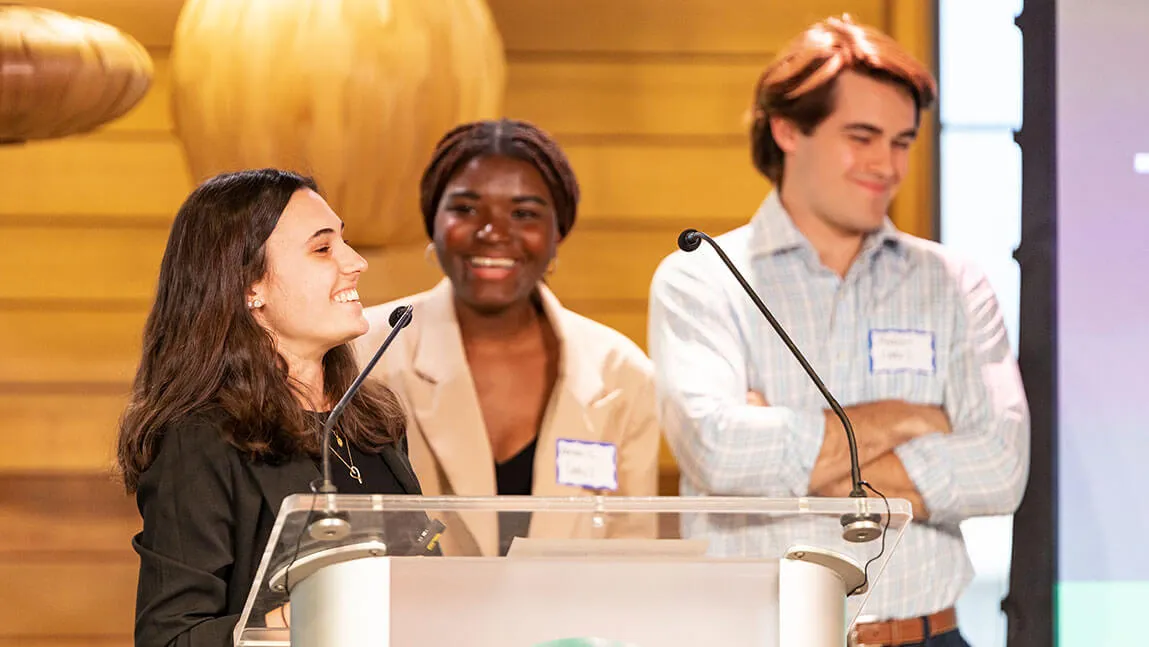The process of commercializing established technology can be arduous, especially in an academic, research-focused environment like a university. But that’s what the Academic Research Commercialization (ARC) program does. Led by UVM seniors Skylar Bagdon and Sarah Horrigan and driven by both the UVM Entrepreneurship Club and UVM Innovations, ARC takes technology developed by UVM researchers and faculty and brings them to the mainstream, conducting customer discoveries and pitching the ideas to a real-world audience.
“Faculty and researchers came to academia because they wanted to teach and they wanted to do research. They sometimes aren’t in a position to just quit their jobs and do a risky startup full time,” Bagdon said. “And students, especially entrepreneurial students, are always looking for creative opportunities. They want to take risks. They want to do things that can have a huge impact.”
Students involved in the ARC program made their pitches during UVM Innovation’s 2022 Invention2Venture (I2V) Conference, a yearly event that pulls together dynamic experts, academic researchers, students, entrepreneurs and business leaders from across Vermont and New England to talk about how to protect, develop and finance the next generation of ideas.
One of the ideas ARC students presented was that of Verde Technology’s thin-film solar panels. Verde Technologies is the product of professor and physics department chair Randall Headrick and postdoctoral student Richards Miller.
“A huge problem right now is that installing solar (panels) sucks. It’s really expensive, but it’s also impractical sometimes,” junior Nicole Eaton said during her ARC group’s presentation. “Up to 40% of the cost of solar is installation, system design, and permitting. It can also be more if you’re trying to install on atypical roofs, especially in Vermont where we have so many farms. And right at home, we have the Gutterson Field House where we can’t have solar, because it’s a curved roof.”
Verde Technologies’ solution is a thin-film, flexible solar panel using perovskites, a material that has the same crystal structure as calcium titanium oxide, the first-discovered perovskite crystal. These solar panels are cheaper, simpler to install, and highly efficient.
“It’s a roll-out solar panel that has adhesive backing,” Eaton said. “In the lab, we are projected to reach 28% efficiency. In the field, traditional solar panels are usually 18-22% efficient. It’s a big jump.”
Eaton and the rest of the ARC group, graduate student Dorcas Lohese and Mason Tuff, chose to support Verde Technologies because each of their own academic experiences aligned with ARC’s goals in technological commercialization: Eaton is studying public communication; Lohese, biochemistry and pharmacology; and Tuff is studying engineering, hoping to create his own minor in sustainable technology commercialization.
“I started ARC this semester. What really drew me to it? I’m a scientist. I’ve never taken any business or communication classes,” Lohese said in an interview. “But as a career, I wanted to incorporate both science and business so I thought ARC was a great way to gain that hands-on experience. I’ve been able to learn so many things that takes people years but I was able to learn in months: customer discoveries, business models, how to bridge that gap between academia and industry.”
Beyond turning the hard work of researchers and academics into viable commercial technologies, ARC also promotes student independence.

“Although we do work for (faculty and researchers), we’re really supposed to be commercializing (the technology) for them,” Eaton said in an interview. “Chad (Miller) and Randall (Headrick) really gave us the independence to do that and just trust us in that process and they really let us take the lead. They had a goal that we could help achieve, but also just because they were super open to working with us and just to trusting us because they knew that they couldn't do it themselves.”
Tuff hopes to build his entrepreneurial skills as an ARC member.
“Particularly with the technology we’re working on now, it's directly aligned with what I ultimately think I want to do: combine sustainable technology with entrepreneurship,” Tuff said in an interview. “I want to start my own business at some point in my life and having these experiences under my belt is huge.”
ARC continues through the summer, with students spending the bulk of what would be vacation time on commercialization research. Last summer, the ARC program worked with faculty members Ryan McGinnis and Ellen McGinnis on PanicMechanic, a mobile app to help sufferers of panic attacks.
“We always say 20% gets done in the spring, 80% gets done in the summer,” Eaton said. “Spring gives everyone time to step their toes in the water and then in the summer we work together every day and just do as much as we can to make the businesses…commercial ready and fully functioning.”
Eaton is taking over as leader of the ARC program after Bagdon graduates this May and he has the utmost confidence in her ability to continue the program’s mission.
“Nicole is the star example of a student rising to the occasion and seizing opportunities in front of her,” Bagdon said. “She started as an entry level team member, got promoted to head of partnerships, then team lead, and now she has earned her rightful title of program director. Her growth has been truly astounding and I'm confident that under her leadership the ARC will reach new heights.”
